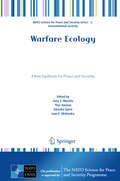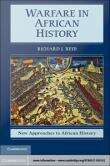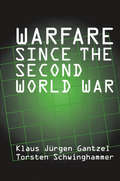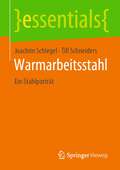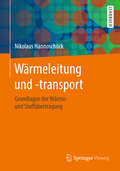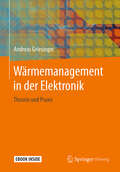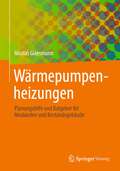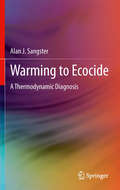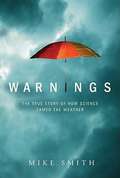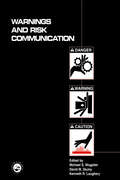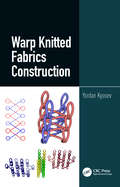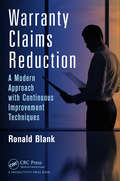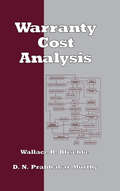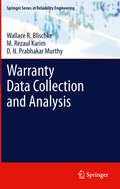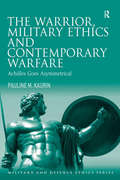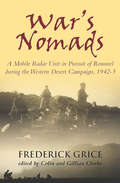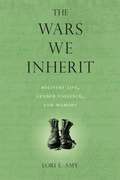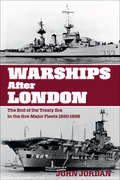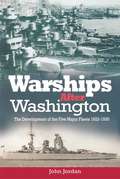- Table View
- List View
Warfare Ecology
by Gary E. Machlis Jean E. Mckendry Thor Hanson Zdravko ŠpirićThe purpose of this book is specific and ambitious: to outline the distinctive elements, scope, and usefulness of a new and emerging field of applied ecology named warfare ecology. Based on a NATO Advanced Research Workshop held on the island of Vieques, Puerto Rico, the book provides both a theoretical overview of this new field and case studies that range from mercury contamination during World War I in Slovenia to the ecosystem impacts of the Palestinian occupation, and from the bombing of coral reefs of Vieques to biodiversity loss due to violent conflicts in Africa. Warfare Ecology also includes reprints of several classical papers that set the stage for the new synthesis described by the authors. Written for environmental scientists, military and humanitarian relief professionals, conservation managers, and graduate students in a wide range of fields, Warfare Ecology is a major step forward in understanding the relationship between war and ecological systems.
Warfare in African History
by Richard J. ReidThis book examines the role of war in shaping the African state, society, and economy. Richard J. Reid helps students understand different patterns of military organization through Africa's history; the evolution of weaponry, tactics, and strategy; and the increasing prevalence of warfare and militarism in African political and economic systems. He traces shifts in the culture and practice of war from the first millennium into the era of the external slave trades, and then into the nineteenth century, when a military revolution unfolded across much of Africa. The repercussions of that revolution, as well as the impact of colonial rule, continue to this day. The frequency of coups d'états and civil war in Africa's recent past is interpreted in terms of the continent's deeper past.
Warfare Since the Second World War
by Torsten SchwinghammerWarfare Since the Second World War presents a wealth of analysis and data about one of the most pressing questions of our time: why does war continue to plague us fifty years after World War II? This book argues that the nature of war has shifted from inter-state conflicts toward internal conflicts, above all civil war. Low-intensity conflict helps explain the constant increase in wars over the last fifty years and makes it probable this trend will continue. Gantzel and Schwinghammer argue that modern warfare reflects a continuation of the nation-state-building process begun in nineteenth-century Europe.In their analysis, economic modernization and social integration destroy traditional relations and create instability in the developing world. While these forces were successfully harnessed by the modern state in Europe and North America, economic and political globalization make a similar resolution considerably more complex. In addition to their insightful analysis, the authors provide a detailed list of all wars fought from 1945 to 1995. The authors' lucid explanatory commentaries are accompanied by lists, tables, and charts. In addition to a detailed war register, upon which all statistical data and analyses for the volume are based, there are appendices with directories useful for locating specific wars, as well as several supplementary lists. An afterword brings the reader closer to the world situation as we conclude the twentieth century; including the impact of political developments in Eastern Europe.Beyond its historical dimension, this book offers a policy-relevant empirical demonstration of the ongoing increase in internal (civil) wars and addresses the inability of modern society to prevent this scourge. Warfare Since the Second World War is an indispensable resource for anyone concerned with issues of war and peace, development, and the future of international relations.
Wargames
by Martin Van CreveldWhere did wargames come from? Who participated in them, and why? How is their development related to changes in real-life warfare? Which aspects of war did they capture, which ones did they leave out, how, and why? What do they tell us about the conduct of war in the times and places where they were played? How useful are they in training and preparation for war? Why are some so much more popular than others, and how do men and women differ in their interest? Starting with the combat of David versus Goliath, passing through the gladiatorial games, tournaments, trials by battle, duels, and boardgames such as chess, all the way to the latest simulations and computer games, this unique book traces the subject in all its splendid richness. As it does so, it provides new and occasionally surprising insights into human nature.
Warmarbeitsstahl: Ein Stahlporträt (essentials)
by Joachim Schlegel Till SchneidersDie Welt des Stahls ist erstaunlich vielfältig und so komplex, dass sie in der Praxis nicht leicht zu überblicken ist. In Form von essentials zu Porträts von ausgewählten Stählen und Stahlgruppen soll dem Leser diese Welt des Stahls nähergebracht werden; kompakt, verständlich, informativ, strukturiert mit Beispielen aus der Praxis und geeignet zum Nachschlagen. Die Warmarbeitsstähle betreffen eine Gruppe der für Werkzeuge geeigneten, legierten Stähle mit hoher Warmfestigkeit. Diese können im Einsatz Oberflächentemperaturen bis zu 400 °C aushalten. Hierfür werden sie optimal an die unterschiedlichsten Anforderungen insbesondere für Werkzeuge der Warmumformung und des Druckgießens angepasst. Wichtig sind die chemischen Zusammensetzungen, Verfahren der Herstellung und Bearbeitung sowie deren Eigenschaften bzw. die Werkstoffdaten der Warmarbeitsstähle, die in diesem essential kurz gefasst und übersichtlich vorgestellt werden.
Wärmeleitung und -transport: Grundlagen der Wärme- und Stoffübertragung
by Nikolaus HannoschöckWärme wird in Maschinen und verfahrenstechnischen Anlagen, in der thermischen Energietechnik und in der Bauphysik genutzt oder muss, dort wo sie stört, aus Systemen weggeführt werden. Dieses Lehrbuch handelt vom Wärmetransport und Temperaturfeldern und ihrer Berechnung. Der erste Teil ist eine praxisnahe Einführung und orientiert sich an Aufgabenstellungen, wie sie typisch für den Maschinenbau, die Verfahrenstechnik und die Bauphysik sind. Weitere Kapitel gehen detailliert auf den Wärmeaustausch an Grenzflächen und die Berechnungsverfahren für den stationären und instationären Wärmetransport ein. Der Anhang enthält ein großes Verzeichnis von thermophysikalischen Materialwerten, wie man sie für die Arbeit in der Praxis benötigt.
Wärmemanagement in der Elektronik: Theorie und Praxis
by Andreas GriesingerDas Buch gibt einen Überblick über das Wärmemanagement elektronischer Systeme.Neben den physikalischen Grundlagen der Wärmeübertragung werden passive und aktive Kühlmethoden vorgestellt. Dazu gehören Technologien auf Bauelement- und Substratebene, thermische Interfacematerialien, Kühlkörper, Lüfter und Heatpipes.Für die Analyse von Wärmepfaden werden etablierte und neue Messverfahren beschrieben. Diese liefern thermophysikalische Stoffwerte und thermische Kontaktwiderstände. Zahlreiche Beispiele unterstreichen den Praxisbezug.
Wärmepumpenheizungen: Planungshilfe und Ratgeber für Neubauten und Bestandsgebäude
by Nicolas GlaesmannDieses Buch erläutert alle relevanten Fragen, die für Hausbesitzer oder private Bauherren zum Thema Wärmepumpenheizungen relevant werden können. Mit Hilfe der Inhalte ist es möglich, die Sinnhaftigkeit des Einbaus einer Wärmepumpenheizung für die eigenen Gegebenheiten zu beurteilen.In den Kapiteln werden die Wirtschaftlichkeit, die Umweltverträglichkeit, die Technik im Allgemeinen, die Planung einer Wärmpumpenheizung sowie Optimierungsmöglichkeiten besprochen. Insbesondere wird dabei auf Wärmepumpen in Bestandsgebäuden eingegangen. Ebenso werden verschiedene Möglichkeiten der Einbindung der Wärmepumpe in die Hauptkomponenten der Heizungsanlage, der Wärmequellen- und Wärmenutzungsanlage dargestellt. Die Einsatzbereiche Kühlung und Warmwasserbereitung mit der Wärmepumpe werden erläutert.Erfahrungen aus der Praxis sowie nachvollziehbare Beispiele ergänzen die sachbezogenen Inhalte. Beispielberechnungen bieten Anhaltspunkte für die Vorgehensweisen und ermöglichen die Prüfung von Fachplanern oder eine eigene grobe Vorplanung.Ziel des Buches ist es, Bauherren bei einer eigenständigen Beurteilung zu unterstützen indem ein objektives Verständnis über die Funktionsweise, Planung und Zweckmäßigkeit von Wärmepumpenheizungen unter den gegebenen Umständen geschaffen wird und ggf. unbegründete Vorbehalte nachvollziehbar zerstreut werden.
Wärmeübertragung: Grundlagen und Praxis
by Thomas Wetzel Peter BöckhDieses Buch vermittelt wie kein anderes die Grundlagen der Wärmeübertragung. Es versetzt den Leser in die Lage, Wärmeübertrager auszulegen sowie Wärmeübertragungsaufgaben aller Art zu analysieren und praktische Lösungen dafür zu finden. Auf ausgedehnte theoretische Herleitungen wird verzichtet, stattdessen werden die wesentlichen Zusammenhänge anhand zahlreicher Beispiele aus dem Ingenieuralltag verdeutlicht.Nach der Einführung in die grundlegenden Begriffe wird der Leser Schritt für Schritt mit den wichtigsten Wärmeübertragungsformen vertraut gemacht. Behandelt werden stationäre und instationäre Wärmeleitung, freie und erzwungene Konvektion, berippte Oberflächen, Kondensation und Verdampfung, Wärmestrahlung sowie die Berechnung von Wärmeübertragern. Ein deutsch-englisches Glossar ergänzt den Stoff. Für die 7. Auflage wurden die Kapitel 3 und 8 überarbeitet und mit neuen Beispielen ergänzt. Anpassungen und Korrekturen aufgrund von Hinweisen der Nutzer des Buches ergänzen die Überarbeitung.Die ZielgruppenEin Buch für Studierende an Universitäten und Fachhochschulen sowie für Ingenieure in der Praxis. Das Buch eignet sich auch als Begleitbuch zum VDI-Wärmeatlas.
Warming to Ecocide
by Alan J. SangsterDespite scientific evidence that business-as-usual is unsustainable, there is a huge and widespread inertia to 'greening' the planet. Warming to Ecocide considers climate change from a thermodynamic perspective and asks whether market-driven organisations have carried us to the point of no return through the flawed economics of endless growth. Warming to Ecocide begins by exploring the thermodynamic origins of climate change. It demonstrates that equilibrium thermodynamics can provide full explanations for the basic processes of life such as photosynthesis and metabolism, and that non-equilibrium thermodynamics is close to providing an explanation for how life started. Armed with a solid appreciation of the power of thermodynamics, the second half of Warming to Ecocide discusses whether multinational corporations have convinced the public that climate change is insignificant and thereby neutered any all attempts by governments to espouse environmentally-friendly policies. It then goes on to offer strategies whereby mankind may avoid propelling the global average temperature above the pre-industrial level by more than 2°C, which scientists view as a threshold presaging catastrophic run-away processes.
The Warning (Maximum Ride Ser. #Bk. 4)
by James PattersonTwo roads lead to Mount Hope. None leads out. There's no place to run in a community that's been taken--and is being intentionally kept--off the grid. A small southern town was evacuated after a freak power-plant accident. As the first anniversary of the mishap approaches, some residents are allowed to return past the national guard roadblocks. <P><P>Mount Hope natives Maggie and Jordan quickly discover that their hometown is not as it was before. Downed cellular networks fail to resume service. Animals savagely attack humans. And the damaged power plant, where Jordan's father is an engineer, is under military lockdown. <P><P>As friends and family morph into terrifying strangers, the Maggie and Jordan increasingly turn to each other. Their determination to discover who--or what--has taken control of Mount Hope soon has them in the cross-hairs of a presence more sinister than any they could have imagined. <P><P><b> A New York Times Bestseller </b>
Warnings: The True Story of how Science tamed the Weather
by Mike SmithExperience the most devastating storms of the last fifty years through the eyes of the scientific visionaries who took them on and tamed them. Science and politics collide in this thrilling account of America's struggle for protection against the deadly threat of violent weather. Warnings tells the dramatic true stories of the unsung weather warriors who save innocent lives, often by risking their own.
Warnings and Risk Communication
by Michael S. Wogalter David M. Dejoy Kenneth R. LaugheryWith contributions from leading international experts, this book provides a comprehensive review of warnings and risk communications. The authors explain how best to communicate warnings, whether certain communications are effective, and what factors influence the communication process and address the major issues in theory, research, and applications of warnings and risk communication. The book is an authoritative sourcebook on the theory, research, and applications in the field. It provides a resource for professionals and academics in diverse domains that range from human factors/ergonomics, engineering psychology, marketing, and design, to industry, government, and litigation.
Warp Knitted Fabrics Construction
by Yordan KyosevThe aim of this book is to provide the background of the warp knitting patterning with a large amount of simulated 3D images of the structures, corresponding to the modern available tools for this. The warp knitted structures can have very complex architectures and very limited understanding exists on how they are built. The pattern book will allow
Warranty and Preventive Maintenance for Remanufactured Products: Modeling and Analysis
by Ammar Y. Alqahtani Surendra M. GuptaThe exponential increase in the development of technology coupled with the customers’ immense desire to possess the newest technological products makes for truncated product lifespans, which instigates a substantial upsurge in their rate of disposal. Attempts have been made to establish specialized product recovery facilities with the intention of diminishing the volume of accumulated waste delivered to landfills using product recovery procedure such as remanufacturing. The economic benefits produced by remanufacturing also portray the role of product recovery in a more attractive light. The quality of a remanufactured product is uncertain for some consumers. Therefore, these consumers possess insecurities in deciding whether or not the remanufactured products will render the same expected performance. This ambiguity regarding a remanufactured product could possibly result in the consumer deciding against its purchase. With such consumer apprehension, remanufacturers often seek market mechanisms that provide reassurance as to the stable durability that these products still maintain. One strategy that the remanufacturers often use is the utilization of the premise of offering product warranties with preventive maintenance on their products. This book is concerned with the practice and theory of warranty management and preventive maintenance, particularly in relation to remanufactured products’ warranties. Models developed in this book can be used for making the right decisions in offering renewable, nonrenewable, one and two dimensional warranty policies, and for managerial decision in considering maintenance contracts or outsourcing maintenance for remanufactured components and products. Features Discusses a variety of warranty policies and preventive maintenance of remanufactured products (first book to do so) Presents mathematical models and applications for warranty policies using examples and simulation results Considers cost and optimization problems from the remanufacturer's and buyer's points of views Provides a foundation for academicians interested in building models in the area of warranty and preventive maintenance analysis of remanufactured products Offers the essential methodology needed by practitioners involved with warranty and preventive maintenance analysis, along with extensive references for further research
Warranty Claims Reduction: A Modern Approach with Continuous Improvement Techniques
by Ronald BlankReduced market share, lack of repeat customers, and added costs are just a few ways warranty claims can hurt an organization. Avoiding complex mathematics or accounting terminology, Warranty Claims Reduction: A Modern Approach with Continuous Improvement Techniques explains how to boost profits through the reduction of warranty expenses in your org
Warranty Cost Analysis
by Wallace BlischkeConsiders cost and optimization problems from the manufacturer's and the buyer's points of view. The work discusses a variety of warranty policies and the mathematical models for the analysis of related engineering and management issues. All standard consumer product warranties are covered.
Warranty Data Collection and Analysis
by Wallace R. Blischke D. N. Murthy M. Rezaul KarimWarranty Data Collection and Analysis deals with warranty data collection and analysis and the problems associated with these activities. The book is a both a research monograph and a handbook for practitioners. As a research monograph, it unifies the literature on warranty data collection and analysis, and presents the important results in an integrated manner. In the process, it highlights topics that require further research. As a handbook, it provides the essential methodology needed by practitioners involved with warranty data collection and analysis, along with extensive references to further results. Models and techniques needed for proper and effective analysis of data are included, together with guidelines for their use in warranty management, product improvement, and new product development. Warranty Data Collection and Analysis will be of interest to researchers (engineers and statisticians) and practitioners (engineers, applied statisticians, and managers) involved with product warranty and reliability. It is also suitable for use as a reference text for graduate-level reliability programs in engineering, applied statistics, operations research, and management.
The Warrior, Military Ethics and Contemporary Warfare: Achilles Goes Asymmetrical (Military and Defence Ethics)
by Pauline M. KaurinWhen it comes to thinking about war and warriors, first there was Achilles, and then the rest followed. The choice of the term warrior is an important one for this discussion. While there has been extensive discussion on what counts as military professionalism, that is what makes a soldier, sailor or other military personnel a professional, the warrior archetype (varied for the various roles and service branches) still holds sway in the military self-conception, rooted as it is in the more existential notions of war, honor and meaning. In this volume, Kaurin uses Achilles as a touch stone for discussing the warrior, military ethics and the aspects of contemporary warfare that go by the name of 'asymmetrical war.' The title of the book cuts two ways-Achilles as a warrior archetype to help us think through the moral implications and challenges posed by asymmetrical warfare, but also as an archetype of our adversaries to help us think about asymmetric opponents.
Warrior's Dishonour: Barbarity, Morality and Torture in Modern Warfare
by George KassimerisThe characteristic act of men at war is not killing. It is killing by committing shocking and unspeakable atrocities, when circumstances permit. What drives ordinary people into hatred, genocide, inhumanity and evil? What turns friends and neighbours against each other with such savagery? Where does such barbarity come from? This collection examines the anarchy, cruelty and overwhelming confusion of modern warfare. In particular it analyzes: ¢ what happens when morality vanishes from the battlefield and why torture is endemic in modern warfare; ¢ how human rights, in times of war, lose meaning as a set of principles; ¢ whether official propaganda and enemy demonization make barbaric behaviour easier; ¢ how we can develop cultures opposed to torture that damage the legitimacy of our societies. Through a wealth of case studies that have been carefully selected in terms of their themes, approaches and methodologies, this comprehensive volume provokes discussion and enhances understanding from a variety of disciplinary perspectives.
War's Nomads: A Mobile Radar Unit in Pursuit of Rommel during the Western Desert Campaign, 1942–3
by Frederick Grice&“The only known detailed account in existence of the small radar units who played a key part in the Western Desert Campaign . . . Highly recommended&” (Military Modelcraft International). War&’s Nomads is an evocative account of one man&’s experience of life in a mobile radar unit after the battle of El Alamein as Rommel&’s Afrika Korps was relentlessly pursued across the desert through Egypt, Libya, and Tunisia by the Eighth Army. After Fred Grice was called up in 1941, he kept two journals of his experiences. The first deals with waiting to embark after initial training, the journey to the battle zone, and the privations of a low-ranking AC. Daily life onboard a ship is vividly brought to life with details of routine, the cramped conditions, the banter and hobbies used to pass the time by the troops, and the luxurious-by-contrast existence of the officers. The second gives a detailed account of the activities of Unit 606, a radar crew that follows just behind the battlefront. 606 provided radio-detection for the advanced landing grounds being used by RAF fighter-bomber squadrons, because these landing strips, in turn, were the target of the German Luftwaffe and Italian Air Force attacks. It was a tiny unit, never more than ten men, frequently operating for protracted periods in complete isolation. Fred Grice&’s account lyrically evokes the landscape and the often tense and dangerous environment they operated in, pitching the reader into the experience of traveling with the unit in a three-ton truck, finding ingenious solutions to lack of rations and living space, even commandeering an abandoned boat to relax in the sea, while constantly needing to be alert to dodge air attacks. Along with these colorful first-person accounts, War&’s Nomads includes an authoritative introduction explaining the background to the military events of the Western Desert campaign, and the purpose of 606&’s mission, which Grice for security reasons could not talk about: to get to a selection of the two hundred or so landing grounds in the desert with all speed—and then defend them against air attack by using a light warning radar set developed to go operational within an hour.
The Wars We Inherit: Military Life, Gender Violence, and Memory
by Lori E. AmyBy combining personal memoir and critical analysis, Lori Amy links the violence we live in our homes to the violence that structures our larger culture. The Wars We Inherit brings insights from memory and trauma studies to the story of violence in the author's own family. In this brave, fascinating and compelling book, Amy concerns herself with the violence associated with the military, and how this institution of public, cultural violence, with its hypermasculinity, pervades society with physical, verbal, emotional and sexual aggression. She uses her war-veteran father to represent the chaotic and dehumanizing impact of war to show how violence is experienced and remembered. Amy provides examples that support the relationship between military structures and domestic violence, or how the sexual violence that permeates her family prompts debates about the nature of trauma and memory. In addition, Amy employs feminist psychoanalytic theory, cultural and trauma studies, and narrative theory, to explain how torture in Abu Ghraib is on a direct continuum with the ordinary violence inherent in our current systems of gender and nation. Placing individual experience in cultural context, Amy argues that "if we can begin, in our own lives, to transform the destructive ways that we have been shaped by violence, then we might begin to transform the cultural conditions that breed violence. "
Warships After London: The End of the Treaty Era in the Five Major Fleets, 1930–1936
by John JordanThe acclaimed naval historian presents an authoritative study of how the 1930 Treaty of London influenced warship design in the years before WW2. After the Washington Naval Treaty of 1922 put a cap on the construction of capital ships and aircraft carriers, the major navies of the world began building ‘treaty cruisers’ and other warships that maximized power while abiding the restrictions. As the French and Japanese excelled in this arena, Britain and the United States sought amendments that would curb their new cruisers, destroyers, and submarines. The negotiations which resulted in the Treaty of London of April 1930 were fraught, and the agreement proved controversial.Warships After London examines warship developments in the five major navies during the period 1930–1936. Long-term plans were disrupted, and new construction had to be reviewed in the light of the new treaty regulations. This led to new, often smaller designs, and a need to balance unit size against overall numbers within each of the categories.As ships produced under these restrictions were the newest available when war broke out in 1939, this book is a major contribution to understanding the nature of the navies involved. Its value is enhanced by well-chosen photographs and by the author’s original line drawings showing the ships’ overall layout, armament, protection, and propulsion.
Warships After London: The End of the Treaty Era in the Five Major Fleets, 1930–1936
by John JordanThe acclaimed naval historian presents an authoritative study of how the 1930 Treaty of London influenced warship design in the years before WW2. After the Washington Naval Treaty of 1922 put a cap on the construction of capital ships and aircraft carriers, the major navies of the world began building ‘treaty cruisers’ and other warships that maximized power while abiding the restrictions. As the French and Japanese excelled in this arena, Britain and the United States sought amendments that would curb their new cruisers, destroyers, and submarines. The negotiations which resulted in the Treaty of London of April 1930 were fraught, and the agreement proved controversial.Warships After London examines warship developments in the five major navies during the period 1930–1936. Long-term plans were disrupted, and new construction had to be reviewed in the light of the new treaty regulations. This led to new, often smaller designs, and a need to balance unit size against overall numbers within each of the categories.As ships produced under these restrictions were the newest available when war broke out in 1939, this book is a major contribution to understanding the nature of the navies involved. Its value is enhanced by well-chosen photographs and by the author’s original line drawings showing the ships’ overall layout, armament, protection, and propulsion.
Warships After Washington: The Development of Five Major Fleers, 1922–1930
by John JordanThis fascinating study of post-WWI naval powers reveals how international peace treaties influenced the design and engineering of modern warships. The Washington Naval Treaty of 1922 was designed to prevent an arms race between the major naval powers after the First World War. But the new constraint inspired ingenious attempts to maximize the power of ships built within the treaty&’s restrictions. By effectively banning the construction of new battleships for a decade, the signatories shifted their focus to the design and construction of large cruisers. In Warships After Washington, naval historian John Jordan examines the political and strategic background of the Washington Naval Treaty and the subsequent London Treaty of 1930. He then presents a detailed study of the types of warships built by the navies of Britain, the USA, Japan, France. The treaties influenced naval engineering across the board—from the development of capital ships and cruisers to super-destroyers, aircraft carriers, and large submarines.
